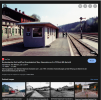When the Vennbahn was still active, Raeren had a quite complex setup, needed to accommodate the following situations :
- passengers bound to stations in Germany had to be controlled
- passengers bound to german stations on the Vennbahn also had to be controlled
- but passengers to belgian stations further down the line were not
So :
- passengers to Germany had to disembark and get controlled in the station
- passengers who remained in Belgium traveled in dedicated cars that were locked whilst crossing german territory
- passengers bound to stations in Germany had to be controlled
- passengers bound to german stations on the Vennbahn also had to be controlled
- but passengers to belgian stations further down the line were not
So :
- passengers to Germany had to disembark and get controlled in the station
- passengers who remained in Belgium traveled in dedicated cars that were locked whilst crossing german territory


